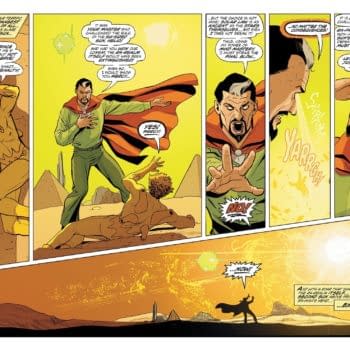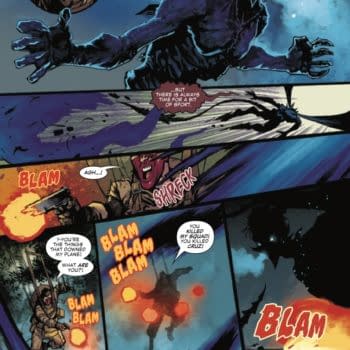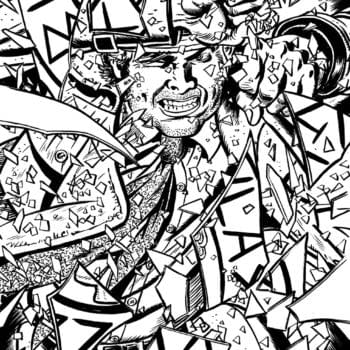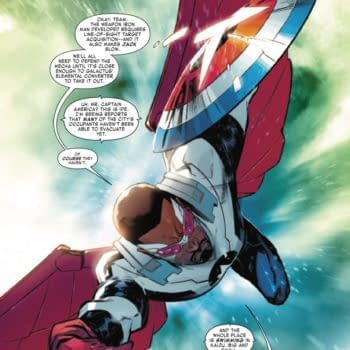Posted in: Comics, Recent Updates | Tagged: Alan Moore, colleen doran, electricomics, garth ennis, john reppion, jose villarubia, leah moore, mitch jenkins, nicola scott, Orphans of The Storm, Paul Davidson, Peter Hogan, Peter Snejbjerg, Simon Bowland, todd klein
Alan Moore Is Creating An Open Access Comics App With Titles From Peter Hogan, Garth Ennis, Leah Moore, And John Reppion (UPDATE)
In a significant announcement landing this morning, (but which we hinted at yesterday from teases on social media), Alan Moore will be partnering with a team of creators and funding bodies to produce a digital comics app called Electricomics which will initially feature four original comics titles, and perhaps most surprisingly, an open-access platform for comics creators to develop digital comics of their own.

Partners on the project include Leah Moore, who has substantial experience in the production of digital comics (via The Thrill Electric) and print comics (Damsels, The Liverpool Demon) and Alan Moore and Mitch Jenkins' company Orphans of the Storm, who produced the Jimmy's End cycle of films successfully funded on Kickstarter, with financial support from the Digital R&D Fund for the Arts.
The app developer, Ocasta Studios, have previously worked with Virgin Media, Vodafone, Harveys and Register, and this will be their first entry into comics media. Since the app will be supported in its development by the Arts and Media Research Council in the UK, the project will have a senior research "team" including Dr. Allison Gazzard from the London Knowledge Lab, Institute of Education, who is a lecturer in Media Arts, and Daniel Merlin Goodbray, who is a senior lecturer at the University of Hertfordshire with an expertise in experimental digital comics. It looks to be a wide-ranging partnership with connections to education, experienced comics creators, and media experts. The scope of the project is particularly ambitious, bringing in not only digital comics publication, but also the creator-access element.
What exactly can creators who wish to develop digital comics expect from the app platform?
According to the project's announcement:
Moore is pushing boundaries again with Electricomics – an app that is both a comic book and an easy-to-use open source toolkit. Being open source and free, the app has wide potential not just for industry professionals, but also businesses, arts organisations and of course comic fans and creators everywhere.
And Alan Moore explains:
Rather than simply transferring comic narrative from the page to the screen, we intend to craft stories expressly devised to test the storytelling limits of this unprecedented technology. To this end we are assembling teams of the most cutting edge creators in the industry and then allowing them input into the technical processes in order to create a new capacity for telling comic book stories.
It will then be made freely available to all of the exciting emergent talent that is no doubt out there, just waiting to be given access to the technical toolkit that will enable them to create the comics of the future.
This "open source toolkit" will, presumably, be test-driven by the creators publishing four unique comic properties, totally 32 pages, via the app initially, and these creators and titles include:
Big Nemo, which will be set in the 1930's, in which Alan Moore revisits Winsor McCay's "most popular hero".
Cabaret Amygdala, a "modernist horror" from writer Peter Hogan (Terra Obscura).
Red Horse, a comic that will appear on the anniversary of the beginning of World War I, from Garth Ennis (Preacher, The Boys) and Danish artist Peter Snejbjerg (World War X) to "take us back to the trenches".
Sway, a "slick new time travel science fiction story" from Leah Moore and John Reppion (Sherlock Holmes – The Liverpool Demon, 2000 AD).
The entire project is dubbed highly "experimental" and their goals are to "explore the possibilities of the comic medium, without the constraints of the industry", shaking off many of the editorial and funding limitations that have led increasing numbers of comics creators to pursue self-publication in recent years.
The fact that the Fund for the Arts is involved suggests that they deem the "experiment" worthy for academic study and codification for the future of media and technology. Their goals, as stated, are:
To see projects that use digital technology to enhance audience reach and/or develop new business models for the arts sector. With a dedicated researcher or research team as part of the three-way collaboration, learning from the project can be captured and disseminated to the wider arts sector.
Every project needs to identify a particular question or problem that can be tested. Importantly this question needs to generate knowledge for other arts organisations that they can apply to their own digital strategies.
From this we can glean that the information and findings from the experiment are indeed going to be available to educational institutions rather than remaining proprietary.
It's an altruistic move that could just jump-start digital comics creation for those who have previously only published in print, and also is bringing new comics to readers in a way that may inspire them to create their own. There also seems to be a goal to present new methods and techniques of digital comics storytelling.
Alan Moore says:
Personally, I can't wait. With Electricomics, we are hoping to address the possibilities of comic strips in this exciting new medium, in a way that they have never been addressed before.
No date has been announced yet for Electricomics' release, and there's an emphasis on the "research" aspect that may mean development is still in its initial phase. However, it's certainly something to look forward to. What will this "technical toolkit" feature and what will these cutting-edge digital comics look like? The anticipation begins.
UPDATE:
The Electricomics website "about us" section also added more information today regarding the origin of the idea for the project and the creators who will be working on the platform, adding Nicola Scott, Jose Villarrubia, Colleen Doran, Paul Davidson, Simon Bowland and Todd Klein to the line-up and explaining that Alan Moore's idea for Electricomics came about while he was working on the Jimmy's End films.
They say:
Welcome to… Electricomics.
Almost three years ago, Alan Moore had an Idea.
Whilst working with director Mitch Jenkins on The Show, an eerie film and TV concept which seemed to have a life of its own, he imagined the children in the background of a scene reading comics on transparent flexible scrolls called Spindles. The comics, he idly supposed, would be Electricomics and would be yet another facet of the multi-nuanced and multimedia world of The Show.
So far so dull right? Big Idea Man has yet another idea.
Wrong.
Alan Moore ideas have an uncanny habit of inveigling themselves into reality, by fair means or foul, they emerge somewhere and demand to be taken seriously.
Almost a year on, when the small film project had inflated in the manner of an airbag deployed in case of cultural stupor, to become not just one but several films, not just one story but dozens of them woven together into a huge billowing cloud of wonder. It was then, that a colleague of theirs happened to chat to a friend and mention that scrappy little idea, Electricomics.
That was all the chance it needed, and before you could say 'Hold on is this wise?' or ' Don't we all have other jobs to do?' there was a meeting and a pitch and a funding application to the Digital Research & Development fund for the Arts. The path was not straight or quick, but in the end it arrived here, in this website, in this project, before your very eyes.
The team that was assembled then could not be more delighted, and more than a little surprised, to find themselves here and now in this position. They have been charged with the task of producing new comics for the digital age. They must attempt new storytelling techniques, create and use new comic making tools which they must then make freely available to everyone.
This large and somewhat daunting burden will be shared with them by the mighty talents of Leah Moore, John Reppion, Garth Ennis, Nicola Scott, Jose Villarrubia, Pete Hogan, Peter Snejbjerg, Colleen Doran, Paul Davidson, Simon Bowland and Todd Klein. Supporting these fine folk will be the research team of Dr Alison Gazzard from the London Knowledge Lab, Institute of Education and Daniel Merlin Goodbrey from The University of Hertfordshire.
The stories produced will not only showcase what is possible but also hopefully inspire others to do the same. The Electricomics toolkit will give users the power to create their own Electricomics.
Different, better comics, completely new and fresh in every way.
Right now, as this project launches, Electricomics is still an idea up in the ether, a hope and a plan before it becomes a reality, but like I said, Alan Moore ideas usually find a way to get through.
Electricomics.
Coming soon.
In addition to their Facebook page, website, and Tumblr, you can also follow Electricomics on Twitter for updates on the project.


















